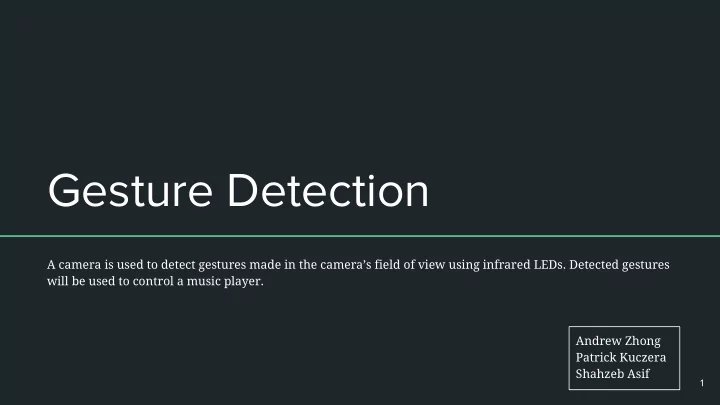

Gesture Detection A camera is used to detect gestures made in the camera’s field of view using infrared LEDs. Detected gestures will be used to control a music player. Andrew Zhong Patrick Kuczera Shahzeb Asif 1
Motivation/Goals ● The ideal performance case is to be able to use the LED to “conduct” music. ● The program should be able to seamlessly recognize one gesture leading into another. ● A possible extension may include multiple audio streams and the ability to conduct them as if they’re different orchestra sections. 2
Basic Functionality ● Gestures are made using an LED. ● A camera is used to track the movement of the LED in an image frame and find the location of the LED in an image frame. ● The stream of location information is compared to stored gestures to recognize the movement of the LED as a gesture. ● Recognized gestures will be used to control music. Gestures will be assigned to play, pause, etc. 3
Hardware ● LEDs ● NTSC out camera ● Altera DE2 ● Monitor ● Speakers 4
Program Design 5
Trie Data Structure Pseudocode struct Node { // Public. int direction; // Returns -1 if node is not leaf node. struct Node *parent; // Else returns gesture_code. struct Node *children; int getGestureCode(struct Node *node) { int gesture_code; } }; // Public. // Public. int addGesture(int gesture_code, char *gesture_string) { struct Node *getBase(void) { } } // Private. // Public. void createNode(int direction, struct Node *parent) { // Returns current if at leaf node. } // Returns null if DNE. // Else returns child with correct direction. // Private. struct Node *nextNode(int direction, struct Node *current) { void addChild(struct Node *parent, struct Node *child) { } } 6
Gesture Recognition ● Gesture recognition will be done using a hybrid trie/graph-like data structure. ● The stream of input position information is at a stable sampling rate. ● A pointer will be moved through the structure as new position information is streamed in. ○ If the input direction cannot be found, the pointer will be reset to root and will begin searching again. ○ If the input direction is found, the pointer will be updated and search will continue. If the input direction is found and the node is a leaf node, the ○ gesture code will be returned. 7
Performance ● The biggest bottleneck is processing input frames. ● Processing input frames will be done on a stream rather than storing anything to memory. ● All image processing will be done in hardware to get the best performance. ● Audio modulation will also be done on hardware. ● Software will be relegated to relatively straight-forward tasks and used as a controller rather than a processor. 8
Test Plan ● Testing will be done in modular pieces and with incremental testing. ● LED detection was prototyped using a MATLAB program and will be tested independently of other modules by printing position information to LCD and using video out. ● Gesture recognition can be tested independently using a mocked C program and dummy LED position data. It will also be tested with actual LED position detector output. ● Audio modulation can be prototyped in MATLAB as well. It will be tested using mocked commands and while connected to the other modules. 9
Questions? 10
Recommend
More recommend